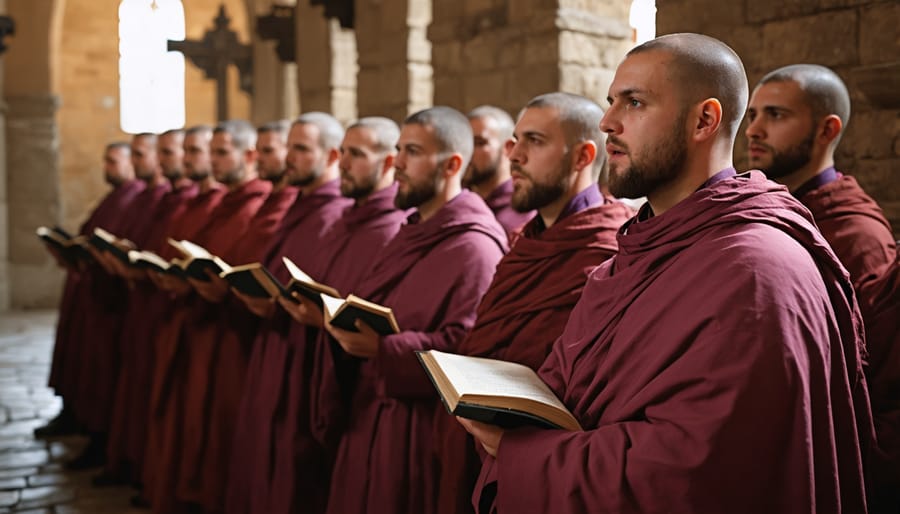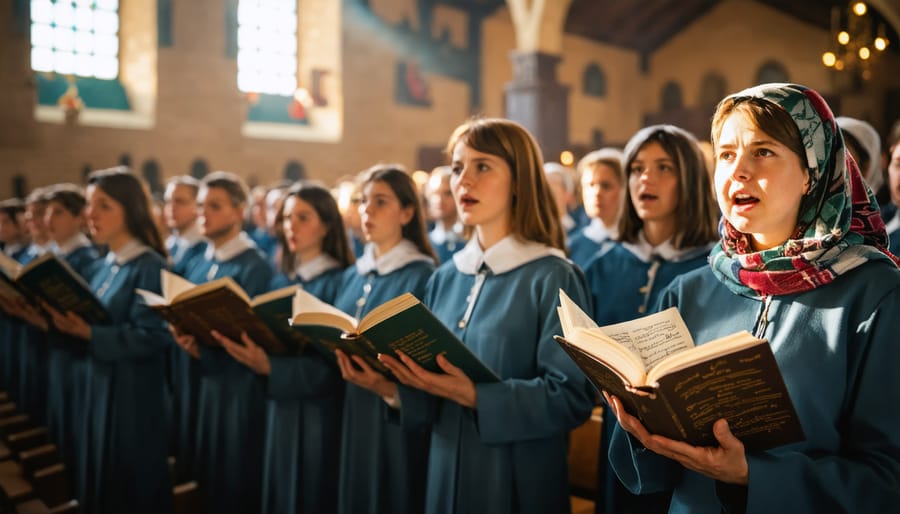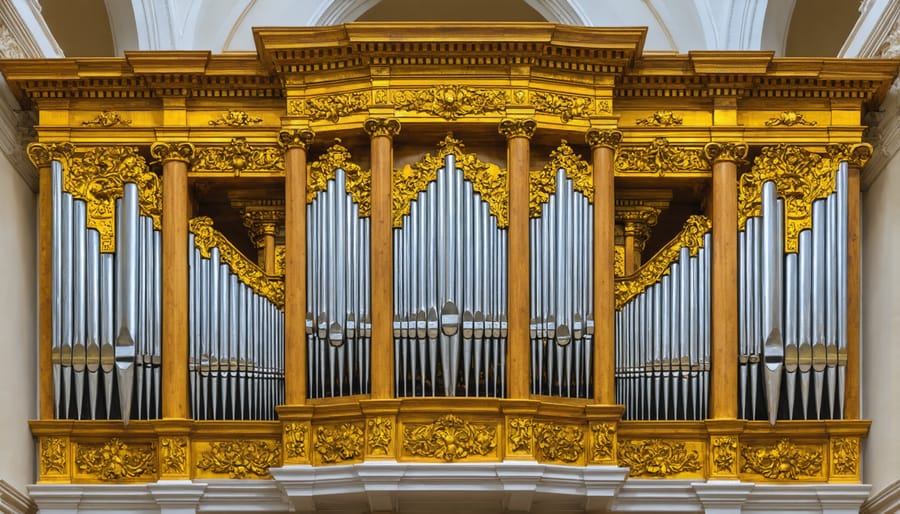Sacred traditions weave the timeless threads of faith through generations, connecting ancient practices to modern worship. From the reverent echoes of sacred music traditions to the breaking of bread in holy communion, these rituals shape our spiritual journey and deepen our connection with the divine. Throughout history, believers have preserved these sacred practices as precious gifts, passing them down through careful instruction and devoted observance. Whether in grand cathedrals or humble gatherings, these traditions transcend time and culture, offering profound moments of encounter with God. As we explore five exemplary sacred traditions, we’ll discover how these ancient practices continue to breathe life into contemporary worship, inviting believers into a deeper understanding of their faith heritage while fostering unity across denominational boundaries. Each tradition carries within it the wisdom of centuries and the power to transform our modern spiritual experience.

Gregorian Chant: The Ancient Voice of Prayer
Origins and Spiritual Significance
Gregorian chant, named after Pope Gregory I (540-604 AD), emerged during the early centuries of Christianity as a sacred form of musical worship. This melodic prayer tradition developed in monasteries and churches across Europe, where monks and clergy would sing Biblical texts, particularly the Psalms, in Latin. The chants were carefully crafted to enhance the spiritual experience of both performers and listeners, with their flowing melodies designed to elevate the soul toward heaven.
These sacred songs hold profound spiritual significance as they embody the ancient Christian belief that music serves as a vehicle for divine communication. The simplicity and purity of Gregorian chant reflects Jesus’s teaching that “blessed are the pure in heart, for they shall see God” (Matthew 5:8). The meditative nature of these chants creates an atmosphere of reverence and contemplation, allowing worshippers to focus deeply on prayer and scripture while participating in a tradition that has united believers across generations.
Today, many churches continue to incorporate elements of Gregorian chant in their worship services, recognizing its enduring power to foster spiritual connection and communal unity.
Modern Practice and Revival
Today, Gregorian chant in worship continues to inspire and uplift congregations worldwide. Many churches have revived this ancient practice, recognizing its power to create a contemplative atmosphere that draws believers closer to God. Contemporary worship services often blend traditional chants with modern musical elements, making these sacred melodies accessible to new generations of worshippers.
The Vatican II reforms encouraged broader participation in liturgical music while preserving the beauty of traditional chant. Monasteries and convents remain strongholds of this practice, maintaining daily offices where these timeless melodies echo through ancient halls. Additionally, youth choirs and worship teams are increasingly incorporating chant elements into their repertoire, bridging the gap between historical tradition and modern expression.
This revival reflects a growing appreciation for sacred traditions that connect us to our spiritual heritage while remaining relevant for today’s church. Many believers find that chant’s simple, meditative quality provides a peaceful counterpoint to our fast-paced world.
The Liturgical Calendar and Sacred Music
Advent and Christmas Traditions
The season of Advent and Christmas brings forth some of the most cherished sacred music traditions in Christian worship. During Advent, congregations join in singing ancient hymns like “O Come, O Come Emmanuel,” which dates back to the 8th century and reflects the deep longing for Christ’s arrival. The tradition of Advent carol services, particularly the Festival of Nine Lessons and Carols, beautifully weaves Scripture readings with seasonal hymns, creating a meaningful journey through salvation history.
Christmas Eve candlelight services often feature the beloved “Silent Night,” first performed in 1818 in an Austrian church. The progression from darkness to light as congregants share the flame symbolizes Christ’s light entering the world. Many churches maintain the tradition of performing Handel’s “Messiah,” especially the “Hallelujah Chorus,” which has moved hearts since 1742.
Contemporary churches often blend these traditional elements with modern worship songs, creating bridges between ancient and new expressions of faith. This musical fusion helps each generation connect with the timeless story of Christ’s birth while maintaining the sacred character of the season.
Holy Week and Easter Customs
Holy Week and Easter represent the pinnacle of sacred musical traditions in the Christian calendar. During this sacred season, churches worldwide incorporate ancient hymns and musical customs that have been passed down through generations. The haunting melodies of “Were You There When They Crucified My Lord?” and the triumphant strains of “Christ the Lord Is Risen Today” echo through sanctuaries, connecting modern worshippers to centuries of faithful celebration.
Palm Sunday traditionally begins with processional hymns commemorating Jesus’s entry into Jerusalem. Throughout Holy Week, many congregations observe Tenebrae services, where sacred music gradually diminishes as candles are extinguished, symbolizing Christ’s approaching sacrifice. Good Friday services often feature the singing of the “Reproaches” and solemn a cappella arrangements.
Easter Sunday dawns with jubilant traditions such as sunrise services featuring brass ensembles and choir anthems proclaiming the resurrection. Many churches maintain the tradition of performing Handel’s “Hallelujah Chorus” from “Messiah,” often inviting the congregation to stand and join in this powerful expression of joy and victory. These musical customs create a deeply meaningful journey through the passion and resurrection narrative, allowing believers to participate in the story of salvation through song.

Hymn Singing: A Congregational Heritage
Traditional Hymnody
Traditional hymns have been a cornerstone of Christian worship for centuries, carrying profound theological truths through melodic expressions of faith. These sacred songs connect generations of believers, preserving doctrinal teachings and spiritual experiences in memorable verses and choruses. From classics like “Amazing Grace” to “How Great Thou Art,” hymns provide a rich vocabulary for expressing praise, thanksgiving, and devotion to God.
What makes hymns particularly meaningful is their ability to unite congregations in corporate worship while teaching biblical truths. The carefully crafted lyrics often draw directly from Scripture, helping worshippers internalize God’s Word through song. Many hymns also tell the story of salvation, creating a musical catechism that reinforces fundamental Christian beliefs.
Today, these timeless songs continue to inspire and guide worship services across denominations, often alongside contemporary worship music. Their enduring impact demonstrates how musical traditions can strengthen faith and foster unity within the body of Christ.
Contemporary Adaptations
In today’s worship services, congregations beautifully blend time-honored traditions with contemporary expressions of praise. Many churches maintain their cherished hymnals while incorporating digital projection systems, allowing worshippers to engage with both classic hymns and modern worship songs. Traditional choir arrangements now often feature alongside contemporary instrumental accompaniments, creating rich, multilayered worship experiences that bridge generations.
The practice of responsive readings continues through innovative formats, including smartphone apps and interactive worship guides. Some congregations have adapted ancient liturgical elements into modern worship sets, weaving traditional call-and-response patterns into contemporary music. The timeless tradition of congregational singing remains central, though now enhanced by multimedia presentations and creative musical arrangements.
This harmonious integration helps preserve sacred heritage while making worship accessible and meaningful to new generations, fulfilling Paul’s encouragement to “sing psalms, hymns, and spiritual songs” (Colossians 3:16) in ways that resonate with today’s church.
Responsive Worship
Psalms and Antiphonal Singing
The tradition of antiphonal singing, deeply rooted in the Book of Psalms, represents one of the most enduring practices in Christian worship. This responsive style of singing originated in ancient Hebrew worship, where congregations would alternate verses, creating a beautiful dialogue of praise. The Psalms themselves often contain natural call-and-response patterns, suggesting they were designed for this participatory form of worship.
In early Christian communities, this practice flourished as believers gathered to sing psalms and hymns, with one group responding to another in a harmonious exchange. This tradition not only enhanced the musical experience but also strengthened the sense of community and unified worship. Today, many churches continue this sacred practice through responsive readings and antiphonal choir arrangements.
The power of antiphonal singing lies in its ability to engage the entire congregation, reminding us that worship is both a personal and communal experience. As Psalm 136 demonstrates, with its recurring response “His love endures forever,” this tradition helps worshippers internalize Scripture while participating in a meaningful expression of corporate praise.
Modern Applications
In today’s churches, sacred traditions continue to evolve while maintaining their spiritual essence. Many congregations now incorporate responsive readings through digital displays, making ancient liturgical practices accessible to modern worshippers. Contemporary worship services often blend traditional hymns with modern arrangements, creating bridges between historical and present-day expressions of faith. Prayer beads and contemplative practices have found new life through prayer apps and online spiritual formation groups, helping believers maintain sacred rhythms in their busy lives.
Small groups and house churches have revived the early Christian tradition of intimate fellowship, adapting ancient practices for modern contexts. Many communities now live-stream their services, extending sacred traditions beyond physical walls to reach those unable to attend in person. Youth ministries creatively reimagine time-honored practices, using multimedia and interactive elements to engage younger generations with these enduring spiritual disciplines.
This fusion of traditional practices with contemporary methods ensures that sacred traditions remain vibrant and meaningful for today’s believers while preserving their fundamental spiritual purpose.
Sacred Instruments in Worship
Throughout Christian history, sacred instruments have played a vital role in worship, creating an atmosphere of reverence and spiritual connection. The Bible mentions several instruments used in worship, particularly in the Psalms, where we read about cymbals, harps, and trumpets being used to praise the Lord.
The pipe organ holds a special place in Christian worship tradition, particularly in Western churches. Its majestic sound has been filling cathedral spaces since the Middle Ages, symbolizing the grandeur and glory of God. The organ’s ability to produce both thunderous proclamations and gentle whispers makes it uniquely suited for expressing the full range of worship experiences.
In Eastern Orthodox traditions, bells have served as sacred instruments, calling believers to prayer and marking significant moments in the liturgy. Their resonant tones are believed to represent the voice of God calling His people to worship.
Modern worship services often incorporate various instruments while maintaining their sacred purpose. Guitars, drums, and keyboards, when used reverently, can create meaningful worship experiences that connect with contemporary congregations. As Psalm 150:3-5 teaches us, “Praise him with trumpet sound; praise him with lute and harp! Praise him with tambourine and dance; praise him with strings and pipe! Praise him with sounding cymbals!”
What matters most is not the specific instrument but the heart of worship behind its use, ensuring that all musical offerings serve to glorify God and edify the congregation.

Sacred traditions serve as anchors that connect us to our spiritual heritage while pointing us toward future growth in faith. As we honor these time-tested practices, we recognize their power to unite believers across generations and denominations. However, we must remember that the Holy Spirit continues to move and work in fresh ways among God’s people. Just as the early church balanced reverence for their Jewish roots with openness to new expressions of faith, we too are called to preserve what is precious while remaining receptive to Spirit-led innovation. By maintaining this delicate balance, we ensure that our worship remains both deeply rooted and vibrantly alive. Let us cherish these sacred traditions while staying attuned to how God might be calling us to express our faith in new and meaningful ways for today’s generation.
